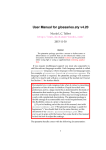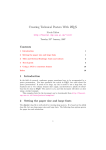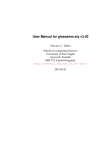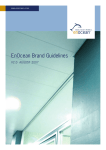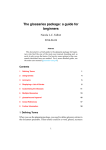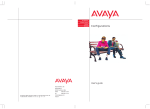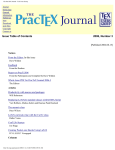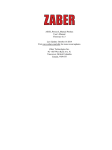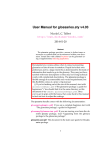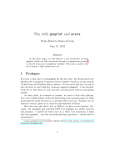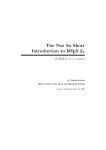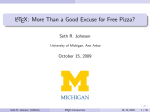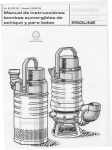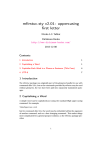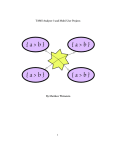Download Creating a LaTeX Minimal Example
Transcript
Creating a LaTeX Minimal Example
Nicola L C Talbot
17th January 2014 (version 1.2)
Abstract
Debugging LaTeX errors often requires creating a minimal (or minimum) example.
This is particularly important when posting a bug report or request for help, as it
facilitates the diagnostic process. Creating a minimal example will often help you
identify the problem, without having the hassle of posting your query and waiting
until you get a reply. This document illustrates how to create a minimal example.
See also Need More Help?
The home page for this document is http://www.dickimaw-books.com/latex/
minexample/. The source code for this document is available as a ZIP archive.
c 2008 Nicola L. C. Talbot Permission is granted to copy, distribute and/or
Copyright modify this document under the terms of the GNU Free Documentation License, Version
1.2 or any later version published by the Free Software Foundation; with no Invariant
Sections, no Front-Cover Texts, and no Back-Cover Texts. A copy of the license is
included in the section entitled “GNU Free Documentation License”.
Contents
1 Introduction
2
2 Building Up
2
3 Hacking Down
5
4 Additional Files
9
5 Dummy Text
10
6 Where Do I Find Package Documentation?
11
7 Understanding Error Messages
11
8 GNU Free Documentation License
13
1
1 Introduction
A minimal example is the smallest possible complete document that illustrates a problem.
A minimal example file should not include any packages or code that do not contribute
to the problem, but must include a document class and the document environment.
There are two approaches to creating a minimal example: “building up” and “hacking
down”. This document illustrates both approaches. Creating the minimal example may
lead you to the solution, but if you are still stuck, you can then post the minimal example.
(Remembering first to search for the solution in the documentation and on the Internal,
for example, in newsgroup archives or on forums or Q&A sites.)
Many package authors (including me) read messages on sites such as The LATEX Community, TEX on StackExchange or on newsgroups such as comp.text.tex, so if you have
a problem you can’t solve it’s generally a good idea to post your query in one of those
places (remembering to paste the contents of your minimal file in your message). If
you’ve made a mistake in your code, then someone may be able to point it out, which
may mean that you get a reply quicker than you would if you posted your query directly
to the author. Also, other people will be able to see your query and learn from it. Remember that no one is being paid or is otherwise obliged to answer your query, so be
careful not to make your query sound like a demand or an accusation.
Note that when posting your query, you also need to give a brief description of the
problem, and list the methods that you have tried to trace the problem. Don’t go into
a long rambling description of your project, as it generally doesn’t help to identify the
problem, and too much information can put people off reading your request. It’s also a
good idea to first search the comp.text.tex archives or use the search box on sites like
The LATEX Community, TEX on StackExchange to find out if anyone else has asked the
same question. If you ask a frequently asked question, you may get a curt reply from
people who are tired of answering the same old question, so check first.
2 Building Up
With the building up approach, you start with the document:
\documentclass{article}
\begin{document}
\end{document}
and add to it until you encounter your problem. If your problem requires the use of
\chapter, then replace article with either report or book.
This section illustrates the building up approach with an example. Suppose your
problem document looks something like:
\documentclass{myuniversityscustomclass}
\usepackage[french,USenglish]{babel}
\usepackage[mmddyyyy]{datetime}
2
\usepackage{nonstandardpackage}
\usepackage{anothernonstandardpackage}
% lots of other packages that may or may not be standard
% lots of your own definitions
\author{John Doe}
\title{Astounding Discoveries}
\begin{document}
\maketitle
\tableofcontents
\listoffigures
\listoftables
% 300 or so pages of text, graphics, tables, bibliography and
% sundry other stuff
\end{document}
Let’s suppose that your problem is that the date on the title page looks like November
14, 2008, but you are expecting it to appear in the form 11/14/2008. You have already
checked that you used the option mmddyyyy when you loaded the datetime package, so
what’s gone wrong?
Since you haven’t used \date, the date on the title page is generated using \today,
so the fault must lie in the definition of \today. It looks like it might be a bug in the
datetime package, so what should you do? This happens to be one of my packages, but
if you send me your entire 300 page document plus several hundred graphics files and
a large bibliography file, I won’t be best pleased. Aside from filling up my inbox, I
don’t have your university’s custom class file, nor am I likely to have the non-standard
packages installed on my system, so I won’t be able to test the document. At which
point you’ll either get a request for a minimal example, or I’ll think “forget that, I’ll
look at it some other day” (or words to that effect) and then several days, or possibly
weeks, later you’ll get a request for a minimal example.1
You’ve already worked out that the problem must lie with the command \today. So
that needs to go in the minimal example. You want to use the datetime package to change
the format of this command, so that package needs to go in the minimal example, with
the package options you have specified in your original document:
\documentclass{article}
\usepackage[mmddyyyy]{datetime}
\begin{document}
\today
1
Actually, these days I’ll just ask you to post your bug report on my bug report form.
3
\end{document}
Call this file, say, test.tex, and run LATEX on it. Have a look at the output. The
output looks fine, so perhaps one of the other packages you have loaded has caused the
problem. One by one try each of the packages you have in your problem document, in the
same order. If adding the package has no effect on the output, then delete that package
from the test file, and go on to the next one. For example, the problem document loads
the babel package, so add that package to the test file using the same options that you
used in your problem document. The minimal example should now look like:
\documentclass{article}
\usepackage[french,USenglish]{babel}
\usepackage[mmddyyyy]{datetime}
\begin{document}
\today
\end{document}
Now run it through LATEX, and check the result. The output has changed to November
14, 2008, instead of 11/14/2008. This test file now reproduces the error, but is only six
lines instead of several hundred or possible thousand lines.
What next? Check the datetime documentation to see if it mentions the babel package.
The datetime documentation comes in both PDF and HTML format. Most PDF and
HTML viewers have a function that allows you to search the document or page for a
given word, so search for the word “babel”. This should lead you to the sentence which
states that the babel package must be loaded before the datetime package. Check the
test file. In this test file, the babel package has been loaded first.
Now what? In this case, there is a FAQ for the datetime package (http://www.
dickimaw-books.com/faqs/datetimefaq.html) so that’s the next place to look. This
FAQ covers the most commonly used packages that I have written.2 If you look at
the table of contents for the datetime section, you should see the entry “The date is in
another language or in the wrong format”. This fits the problem, so click on that link
and have a look at the answer. The answer indicates that there was a bug in an earlier
version of the datetime package that caused a problem when used in conjunction with
the babel package, but the bug has been fixed. So the next thing to do is check which
version you are using. Add the command \listfiles to the test file:
\listfiles
\documentclass{article}
\usepackage[french,USenglish]{babel}
\usepackage[mmddyyyy]{datetime}
\begin{document}
\today
\end{document}
2
or more precisely, it covers the packages that I get the most post about.
4
At the end of the log file there should now be a list of all the files that have been loaded,
along with their release dates and versions. Check the version of the datetime package.
Is it the latest version? If not, download the latest version and try again. If it is the
latest version, then send the author (me, in the case of the datetime package) the test
file and its log file. If you check the package documentation, you should either find the
author’s contact details or a link to a bug reporting tool.
If the conflicting package is one that is not publicly available (for example, it’s your
university’s custom package that can only be downloaded from a restricted site) then
send your query to the author of that package. If the conflicting package is publicly
available, but is not on CTAN, then specify from where it can be downloaded.
3 Hacking Down
The previous section illustrated how to build up a minimal example. This section shows
how to hack down a minimal example. Again, we are going to start with a 300 page
document which contains many images, tables and a bibliography.
\documentclass{myuniversityscustomclass}
\usepackage{nonstandardpackage}
\usepackage{anothernonstandardpackage}
% lots of other packages
\usepackage{glossaries}
% lots of your own command and environment definitions
\newglossaryentry{minex}{name={Minimal Example},
description={A small document illustrating failing behaviour},
text={minimal example}}
% lots more glossary definitions
\author{John Doe}
\title{Astounding Discoveries}
\begin{document}
\maketitle
\tableofcontents
\listoffigures
\listoftables
% 300 or so pages of text, graphics, tables and
% sundry other stuff
5
% Somewhere in the document is the following:
A \gls{minex is essential when encountering a \TeX\ or \LaTeX\
error you don’t understand.
% Lots more text, figures, tables and a bibliography
\end{document}
This document is causing the following error:
Runaway argument?
{minexam is essential when encountering a \TeX \ or \LaTeX \^^Merror
\ETC.
! Paragraph ended before \\@gls was complete.
<to be read again>
\par
Suppose you don’t understand what the error is or whereabouts in the document it is
occurring3 .
Since you don’t know what command is causing the problem, you can’t use the approach illustrated in the previous section. So you will need to use the hacking down
approach.
Before doing anything else, make a copy of the problem document. Call the copy, say,
test.tex, and only edit this. Don’t start messing around with the original document
until you’ve solved the problem, otherwise you could lose your work!
One way of tracking down the problem is to use a binary search. Suppose your
document contains 1000 lines of source code, then go to line 500 of your test document
(i.e. half-way through it) and insert the line4 :
\end{document}
(Make sure you don’t put it inside a group or environment.)
Now pass the test document to LaTeX. You may get some warning messages as a
result of omitting half the document, but don’t worry about that for now.
• If the error still occurs, then the problem is in the first half of the document. In
which case, delete everything after the first \end{document} (in your test file),
and repeat the process.
• If the error goes away, then the problem is in the second half of the document. In
which case, delete everything after \begin{document} up to, and including, the
first \end{document} (in your test file), and repeat the process.
3
Actually, in this example it should print the line number in the error message since \gls is a short
command, but not all runaway argument errors give a helpful line number, so let’s pretend it hasn’t.
4 A
L TEX will finish the document when it reaches the first \end{document}, and ignore everything that
comes after it.
6
Continue the process until you only have one paragraph left in your document. If this
has an \input or \include command, first remove (or comment out) the command. If
the problem goes away then the error is in that file, in which case replace the \input
or \include command with the contents of the relevant file in your test file, and repeat
the process. Once you have finished, it’s a good idea to add \listfiles.
Let’s suppose we now have a test file that looks like:
\listfiles
\documentclass{myuniversityscustomclass}
\usepackage{nonstandardpackage}
\usepackage{anothernonstandardpackage}
% lots of other packages
\usepackage{glossaries}
% lots of your own command and environment definitions
\newglossaryentry{minex}{name={Minimal Example},
description={A small document illustrating failing behaviour},
text={minimal example}}
% lots more glossary definitions
\begin{document}
A \gls{minex is essential when encountering a \TeX\ or \LaTeX\
error you don’t understand.
\end{document}
It may be that you can now identify the problem, but let’s suppose you still don’t
know what’s wrong. The next thing to do is to remove unnecessary information in the
preamble. If you have defined any commands or environments in the preamble that aren’t
used in the problem paragraph, then delete them. This includes any new theorems or
glossary entries and so on. In this example, the problem paragraph contains a glossary
entry, so keep the definition for that entry, and delete all the others:
\listfiles
\documentclass{myuniversityscustomclass}
\usepackage{nonstandardpackage}
\usepackage{anothernonstandardpackage}
% lots of other packages
7
\usepackage{glossaries}
\newglossaryentry{minex}{name={Minimal Example},
description={A small document illustrating failing behaviour},
text={minimal example}}
\begin{document}
A \gls{minex is essential when encountering a \TeX\ or \LaTeX\
error you don’t understand.
\end{document}
Now, one by one, remove any packages that aren’t contributing to the problem. Each
time you remove a package, run the test file through LATEX. If the error goes away, then
put the package back in. If removing a package causes an “Undefined control sequence”
error, then remove the undefined command as well. If the problem goes away, add the
command and package back again. For example, if I remove the line:
\usepackage{glossaries}
then I will get an error as neither \newglossaryentry nor \gls will be defined. If I
remove those commands, the original error message will go away. So I have to leave
those commands in and keep the glossaries package in the test file.
Next, try substituting the class file for the article or report class file. If the error goes
away, then the original class file is contributing to the problem, in which case put it back
again. If this class file is not publicly available (for example, it may be an in-house class
file, such as a university thesis, which has restricted access) then contact the author of
the class file, and send the test file and log file. (Remembering, of course, to first search
the documentation.)
If you followed all of the above steps, then the test file should now look like:
\listfiles
\documentclass{article}
\usepackage{glossaries}
\newglossaryentry{minex}{name={Minimal Example},
description={A small document illustrating failing behaviour},
text={minimal example}}
\begin{document}
A \gls{minex is essential when encountering a \TeX\ or \LaTeX\
error you don’t understand.
8
\end{document}
In this example, you should now be able to work out that there is a missing closing
brace to the argument of \gls. If, however, you still can’t work out the problem, then
(assuming that you’ve already read the documentation and searched relevant forums or
newsgroup archives) copy and paste the test file in a message to somewhere like TEX on
StackExchange or The LATEX Community or comp.text.tex.
4 Additional Files
You’ve tried building up or hacking down a minimal example, but the problem is caused
by an additional file which you can’t copy and paste into the minimal example file, so
what do you do?
If the file is a graphics file, replace the command with a rule of the same dimension.
For example, if your image is 4in wide by 3in high, then replace:
\includegraphics{myImage}
with
\rule{4in}{3in}
Alternatively, the mwe package comes with some sample images that you can use instead.
For example, you could replace
\includegraphics{myImage}
with
\includegraphics[height=3in]{example-image}
(There are other test images provided by that package. See the mwe documentation for
further details.)
If the file is a BibTEX file, then make a copy of the file, and remove the entries one
by one until you are left with the entry that causes the problem. If the file is a CSV
file, make a copy of the file, and remove the rows one by one until you are left with the
problem row (but keep the header row if there is one.) You can then send this abridged
file with the minimal example or you can embed it in the minimal example file using the
filecontents or filecontents* environment5 . This environment takes one argument which
must be the name of the file. For example:
\documentclass{article}
\begin{filecontents*}{test.bib}
@article{sample,
5
The starred form doesn’t write extra comments in the file
9
author={Ann Other},
title={Sample Title},
journal={Journal of Something},
year=2014
}
\end{filecontents*}
\begin{document}
\cite{sample}
\bibliography{test}
\end{document}
5 Dummy Text
Sometimes a problem may only occur at a certain place or after a certain point, in which
case you may need to create some dummy text to pad out your example. If so, the lipsum
package is a useful tool. This provides the command \lipsum which has an optional
argument that specifies the paragraph or the range of paragraphs to typeset.
For example, suppose you are using the book class and you don’t understand why the
page number appears on the bottom of the first page of the chapter and at the top of
the second page. Then you could illustrate this as follows:
\documentclass{book}
\usepackage{lipsum}
\begin{document}
\chapter{Sample}
\lipsum[1-4]
\end{document}
This will produce enough text to generate two pages.
There is another dummy text package called blindtext that provides the commands
\blindtext (for short blocks of text) and \Blindtext (for longer blocks of text). For
example:
\documentclass{book}
\usepackage{blindtext}
\begin{document}
\chapter{Sample}
10
\Blindtext
\end{document}
The blindtext package also provides other commands to provide a random document,
dummy lists etc. See the blindtext documentation for further details.
6 Where Do I Find Package Documentation?
These days most package documentation is provided as a PDF file and, if it is installed
on your system, it can usually be obtained using the texdoc application. If you have a
terminal or command prompt, you can access it by typing texdoc followed by the name
of the package. For example, to obtain the documentation for the datetime package run:
texdoc datetime
Sometimes this may produce just the documented code rather than the user manual.
For example:
texdoc flowfram
will display the documented code. However, in this instance, the first paragraph of that
document tells you that the user manual is in ffuserguide.pdf in which case
texdoc ffuserguide
will produce the user manual.
In some cases (especially for older packages) the documentation may be contained in
a README file in the documentation directory or it may be embedded as comments either
at the start or the end of the .sty or .cls file.
Alternatively, if the documentation was not installed on your system, you can obtain
it from CTAN. You can either use the search box on the CTAN home page or you can
use the URL http://ctan.org/pkg/hnamei where hnamei is the name of the package.
For example, to obtain information on the glossaries package, you can use the URL
http://ctan.org/pkg/glossaries and it will provide links to the documentation for
that package.
7 Understanding Error Messages
TEX and LATEX error messages can be cryptic, but sometimes it’s possible to at least
find out where things have gone wrong by studying the message.
Consider the following document:
\documentclass{article}
\newcommand{\example}[1]{#1}
11
\begin{document}
This is a sample document that contains a long
command \example{with an error.
This is the next paragraph
\end{document}
This produces the following error message:
Runaway argument?
{with an error. \par This is the next paragraph \end {document}
! File ended while scanning use of \example.
<inserted text>
\par
The first line (“Runaway argument?”) indicates the type of error. A runaway argument
is usually caused by a missing closing brace. The next line indicates where TEX got up
to before things started to go wrong. In this error message there is no line number but
you can use the information that has been supplied to help you track where the error
might be. Copy the first part of this line (say {with an error) and paste it into your
editor’s search function. This should take you to the relevant line where you can see
that there is no closing brace.
Suppose, instead, the document looked like:
\documentclass{article}
\newcommand*{\example}[1]{#1}
\begin{document}
This is a sample document that contains a short
command \example{with an error.
This is the next paragraph
\end{document}
In this case the error message is:
Runaway argument?
{with an error.
! Paragraph ended before \example was complete.
<to be read again>
\par
l.8
In this example, the error message includes the line number where things started to go
wrong (l.8) so I can use my text editor’s “go to line” function.
Sometimes the line number given in the error message doesn’t correspond to the line
number where the error actually occurs. For example, consider the following document:
12
\documentclass{report}
\author{A.N. Author}
\title{A sample document with a \badcommand}
\date{14th November, 2008}
\begin{document}
\maketitle
\end{document}
In this document the error is an undefined command (\badcommand) occurring on line 4.
However, the error message is:
! Undefined control sequence.
\@title ->A sample document with a \badcommand
l.8 \maketitle
which indicates that the problem occurs on line 8. This is because TEX doesn’t actually
try to interpret \badcommand until line 8 when \maketitle tries to typeset the title
page.
When this type of situation occurs, it may be necessary to do a little bit of detective
work to try to trace the problem. In the above example, there are two methods to try:
1. The first line of the error message states the nature of the error (an undefined
control sequence) and the second line indicates that the undefined control sequence
is \badcommand. You can then use your text editor to search for any instances of
\badcommand and replace it with the correct command. Alternatively, if you have
forgotten to use a package that defines the command or, in the case of a custom
command, you have forgotten to define the command, then do so.
2. The last line of the error message states that the problem was encountered on line 8
which contains the command \maketitle. What commands affect \maketitle?
For the standard classes, such as report, these are: \author, \title and \date,
so inspect the code where these commands are used. Try commenting out all but
one of the commands and see if the error still occurs. For example, if I comment
out the lines containing the title and date, the error goes away, but if I comment
out the author and date instead, the error remains. This means that the error is
in the title.
For further information on understanding error messages, see How to approach errors on
the UK TeX FAQ. There is also a list of some common error messages in the document
LaTeX for Complete Novices which is available from the same site as this document.
8 GNU Free Documentation License
Version 1.2, November 2002
13
c 2000,2001,2002 Free Software Foundation, Inc.
Copyright 51 Franklin St, Fifth Floor, Boston, MA 02110-1301 USA
Everyone is permitted to copy and distribute verbatim copies of this license document,
but changing it is not allowed.
Preamble
The purpose of this License is to make a manual, textbook, or other functional and
useful document “free” in the sense of freedom: to assure everyone the effective freedom
to copy and redistribute it, with or without modifying it, either commercially or noncommercially. Secondarily, this License preserves for the author and publisher a way to
get credit for their work, while not being considered responsible for modifications made
by others.
This License is a kind of “copyleft”, which means that derivative works of the document
must themselves be free in the same sense. It complements the GNU General Public
License, which is a copyleft license designed for free software.
We have designed this License in order to use it for manuals for free software, because free software needs free documentation: a free program should come with manuals
providing the same freedoms that the software does. But this License is not limited to
software manuals; it can be used for any textual work, regardless of subject matter or
whether it is published as a printed book. We recommend this License principally for
works whose purpose is instruction or reference.
1. APPLICABILITY AND DEFINITIONS
This License applies to any manual or other work, in any medium, that contains a
notice placed by the copyright holder saying it can be distributed under the terms of this
License. Such a notice grants a world-wide, royalty-free license, unlimited in duration,
to use that work under the conditions stated herein. The “Document”, below, refers
to any such manual or work. Any member of the public is a licensee, and is addressed
as “you”. You accept the license if you copy, modify or distribute the work in a way
requiring permission under copyright law.
A “Modified Version” of the Document means any work containing the Document
or a portion of it, either copied verbatim, or with modifications and/or translated into
another language.
A “Secondary Section” is a named appendix or a front-matter section of the Document that deals exclusively with the relationship of the publishers or authors of the
Document to the Document’s overall subject (or to related matters) and contains nothing that could fall directly within that overall subject. (Thus, if the Document is in
part a textbook of mathematics, a Secondary Section may not explain any mathematics.) The relationship could be a matter of historical connection with the subject or
with related matters, or of legal, commercial, philosophical, ethical or political position
regarding them.
14
The “Invariant Sections” are certain Secondary Sections whose titles are designated,
as being those of Invariant Sections, in the notice that says that the Document is released
under this License. If a section does not fit the above definition of Secondary then it is
not allowed to be designated as Invariant. The Document may contain zero Invariant
Sections. If the Document does not identify any Invariant Sections then there are none.
The “Cover Texts” are certain short passages of text that are listed, as Front-Cover
Texts or Back-Cover Texts, in the notice that says that the Document is released under
this License. A Front-Cover Text may be at most 5 words, and a Back-Cover Text may
be at most 25 words.
A “Transparent” copy of the Document means a machine-readable copy, represented
in a format whose specification is available to the general public, that is suitable for revising the document straightforwardly with generic text editors or (for images composed
of pixels) generic paint programs or (for drawings) some widely available drawing editor, and that is suitable for input to text formatters or for automatic translation to a
variety of formats suitable for input to text formatters. A copy made in an otherwise
Transparent file format whose markup, or absence of markup, has been arranged to
thwart or discourage subsequent modification by readers is not Transparent. An image
format is not Transparent if used for any substantial amount of text. A copy that is not
“Transparent” is called “Opaque”.
Examples of suitable formats for Transparent copies include plain ASCII without
markup, Texinfo input format, LaTeX input format, SGML or XML using a publicly
available DTD, and standard-conforming simple HTML, PostScript or PDF designed
for human modification. Examples of transparent image formats include PNG, XCF
and JPG. Opaque formats include proprietary formats that can be read and edited only
by proprietary word processors, SGML or XML for which the DTD and/or processing
tools are not generally available, and the machine-generated HTML, PostScript or PDF
produced by some word processors for output purposes only.
The “Title Page” means, for a printed book, the title page itself, plus such following
pages as are needed to hold, legibly, the material this License requires to appear in the
title page. For works in formats which do not have any title page as such, “Title Page”
means the text near the most prominent appearance of the work’s title, preceding the
beginning of the body of the text.
A section “Entitled XYZ” means a named subunit of the Document whose title either
is precisely XYZ or contains XYZ in parentheses following text that translates XYZ in
another language. (Here XYZ stands for a specific section name mentioned below, such
as “Acknowledgements”, “Dedications”, “Endorsements”, or “History”.) To
“Preserve the Title” of such a section when you modify the Document means that it
remains a section “Entitled XYZ” according to this definition.
The Document may include Warranty Disclaimers next to the notice which states that
this License applies to the Document. These Warranty Disclaimers are considered to be
included by reference in this License, but only as regards disclaiming warranties: any
other implication that these Warranty Disclaimers may have is void and has no effect
on the meaning of this License.
15
2. VERBATIM COPYING
You may copy and distribute the Document in any medium, either commercially
or noncommercially, provided that this License, the copyright notices, and the license
notice saying this License applies to the Document are reproduced in all copies, and
that you add no other conditions whatsoever to those of this License. You may not use
technical measures to obstruct or control the reading or further copying of the copies
you make or distribute. However, you may accept compensation in exchange for copies.
If you distribute a large enough number of copies you must also follow the conditions in
section 3.
You may also lend copies, under the same conditions stated above, and you may
publicly display copies.
3. COPYING IN QUANTITY
If you publish printed copies (or copies in media that commonly have printed covers)
of the Document, numbering more than 100, and the Document’s license notice requires
Cover Texts, you must enclose the copies in covers that carry, clearly and legibly, all
these Cover Texts: Front-Cover Texts on the front cover, and Back-Cover Texts on the
back cover. Both covers must also clearly and legibly identify you as the publisher of
these copies. The front cover must present the full title with all words of the title equally
prominent and visible. You may add other material on the covers in addition. Copying
with changes limited to the covers, as long as they preserve the title of the Document
and satisfy these conditions, can be treated as verbatim copying in other respects.
If the required texts for either cover are too voluminous to fit legibly, you should put
the first ones listed (as many as fit reasonably) on the actual cover, and continue the
rest onto adjacent pages.
If you publish or distribute Opaque copies of the Document numbering more than 100,
you must either include a machine-readable Transparent copy along with each Opaque
copy, or state in or with each Opaque copy a computer-network location from which
the general network-using public has access to download using public-standard network
protocols a complete Transparent copy of the Document, free of added material. If
you use the latter option, you must take reasonably prudent steps, when you begin
distribution of Opaque copies in quantity, to ensure that this Transparent copy will
remain thus accessible at the stated location until at least one year after the last time
you distribute an Opaque copy (directly or through your agents or retailers) of that
edition to the public.
It is requested, but not required, that you contact the authors of the Document well
before redistributing any large number of copies, to give them a chance to provide you
with an updated version of the Document.
4. MODIFICATIONS
You may copy and distribute a Modified Version of the Document under the conditions
of sections 2 and 3 above, provided that you release the Modified Version under precisely
16
this License, with the Modified Version filling the role of the Document, thus licensing
distribution and modification of the Modified Version to whoever possesses a copy of it.
In addition, you must do these things in the Modified Version:
A. Use in the Title Page (and on the covers, if any) a title distinct from that of the
Document, and from those of previous versions (which should, if there were any,
be listed in the History section of the Document). You may use the same title as
a previous version if the original publisher of that version gives permission.
B. List on the Title Page, as authors, one or more persons or entities responsible for
authorship of the modifications in the Modified Version, together with at least five
of the principal authors of the Document (all of its principal authors, if it has fewer
than five), unless they release you from this requirement.
C. State on the Title page the name of the publisher of the Modified Version, as the
publisher.
D. Preserve all the copyright notices of the Document.
E. Add an appropriate copyright notice for your modifications adjacent to the other
copyright notices.
F. Include, immediately after the copyright notices, a license notice giving the public
permission to use the Modified Version under the terms of this License, in the form
shown in the Addendum below.
G. Preserve in that license notice the full lists of Invariant Sections and required Cover
Texts given in the Document’s license notice.
H. Include an unaltered copy of this License.
I. Preserve the section Entitled “History”, Preserve its Title, and add to it an item
stating at least the title, year, new authors, and publisher of the Modified Version as
given on the Title Page. If there is no section Entitled “History” in the Document,
create one stating the title, year, authors, and publisher of the Document as given
on its Title Page, then add an item describing the Modified Version as stated in
the previous sentence.
J. Preserve the network location, if any, given in the Document for public access to
a Transparent copy of the Document, and likewise the network locations given in
the Document for previous versions it was based on. These may be placed in the
“History” section. You may omit a network location for a work that was published
at least four years before the Document itself, or if the original publisher of the
version it refers to gives permission.
K. For any section Entitled “Acknowledgements” or “Dedications”, Preserve the Title
of the section, and preserve in the section all the substance and tone of each of the
contributor acknowledgements and/or dedications given therein.
17
L. Preserve all the Invariant Sections of the Document, unaltered in their text and
in their titles. Section numbers or the equivalent are not considered part of the
section titles.
M. Delete any section Entitled “Endorsements”. Such a section may not be included
in the Modified Version.
N. Do not retitle any existing section to be Entitled “Endorsements” or to conflict in
title with any Invariant Section.
O. Preserve any Warranty Disclaimers.
If the Modified Version includes new front-matter sections or appendices that qualify
as Secondary Sections and contain no material copied from the Document, you may at
your option designate some or all of these sections as invariant. To do this, add their
titles to the list of Invariant Sections in the Modified Version’s license notice. These
titles must be distinct from any other section titles.
You may add a section Entitled “Endorsements”, provided it contains nothing but
endorsements of your Modified Version by various parties–for example, statements of
peer review or that the text has been approved by an organization as the authoritative
definition of a standard.
You may add a passage of up to five words as a Front-Cover Text, and a passage of up
to 25 words as a Back-Cover Text, to the end of the list of Cover Texts in the Modified
Version. Only one passage of Front-Cover Text and one of Back-Cover Text may be
added by (or through arrangements made by) any one entity. If the Document already
includes a cover text for the same cover, previously added by you or by arrangement
made by the same entity you are acting on behalf of, you may not add another; but you
may replace the old one, on explicit permission from the previous publisher that added
the old one.
The author(s) and publisher(s) of the Document do not by this License give permission
to use their names for publicity for or to assert or imply endorsement of any Modified
Version.
5. COMBINING DOCUMENTS
You may combine the Document with other documents released under this License,
under the terms defined in section 4 above for modified versions, provided that you
include in the combination all of the Invariant Sections of all of the original documents,
unmodified, and list them all as Invariant Sections of your combined work in its license
notice, and that you preserve all their Warranty Disclaimers.
The combined work need only contain one copy of this License, and multiple identical
Invariant Sections may be replaced with a single copy. If there are multiple Invariant
Sections with the same name but different contents, make the title of each such section
unique by adding at the end of it, in parentheses, the name of the original author or
publisher of that section if known, or else a unique number. Make the same adjustment
18
to the section titles in the list of Invariant Sections in the license notice of the combined
work.
In the combination, you must combine any sections Entitled “History” in the various
original documents, forming one section Entitled “History”; likewise combine any sections Entitled “Acknowledgements”, and any sections Entitled “Dedications”. You must
delete all sections Entitled “Endorsements”.
6. COLLECTIONS OF DOCUMENTS
You may make a collection consisting of the Document and other documents released
under this License, and replace the individual copies of this License in the various documents with a single copy that is included in the collection, provided that you follow the
rules of this License for verbatim copying of each of the documents in all other respects.
You may extract a single document from such a collection, and distribute it individually under this License, provided you insert a copy of this License into the extracted
document, and follow this License in all other respects regarding verbatim copying of
that document.
7. AGGREGATION WITH INDEPENDENT WORKS
A compilation of the Document or its derivatives with other separate and independent
documents or works, in or on a volume of a storage or distribution medium, is called an
“aggregate” if the copyright resulting from the compilation is not used to limit the legal
rights of the compilation’s users beyond what the individual works permit. When the
Document is included in an aggregate, this License does not apply to the other works in
the aggregate which are not themselves derivative works of the Document.
If the Cover Text requirement of section 3 is applicable to these copies of the Document, then if the Document is less than one half of the entire aggregate, the Document’s
Cover Texts may be placed on covers that bracket the Document within the aggregate,
or the electronic equivalent of covers if the Document is in electronic form. Otherwise
they must appear on printed covers that bracket the whole aggregate.
8. TRANSLATION
Translation is considered a kind of modification, so you may distribute translations
of the Document under the terms of section 4. Replacing Invariant Sections with translations requires special permission from their copyright holders, but you may include
translations of some or all Invariant Sections in addition to the original versions of these
Invariant Sections. You may include a translation of this License, and all the license
notices in the Document, and any Warranty Disclaimers, provided that you also include
the original English version of this License and the original versions of those notices and
disclaimers. In case of a disagreement between the translation and the original version
of this License or a notice or disclaimer, the original version will prevail.
19
If a section in the Document is Entitled “Acknowledgements”, “Dedications”, or “History”, the requirement (section 4) to Preserve its Title (section 1) will typically require
changing the actual title.
9. TERMINATION
You may not copy, modify, sublicense, or distribute the Document except as expressly
provided for under this License. Any other attempt to copy, modify, sublicense or
distribute the Document is void, and will automatically terminate your rights under
this License. However, parties who have received copies, or rights, from you under this
License will not have their licenses terminated so long as such parties remain in full
compliance.
10. FUTURE REVISIONS OF THIS LICENSE
The Free Software Foundation may publish new, revised versions of the GNU Free
Documentation License from time to time. Such new versions will be similar in spirit to
the present version, but may differ in detail to address new problems or concerns. See
http://www.gnu.org/copyleft/.
Each version of the License is given a distinguishing version number. If the Document specifies that a particular numbered version of this License “or any later version”
applies to it, you have the option of following the terms and conditions either of that
specified version or of any later version that has been published (not as a draft) by the
Free Software Foundation. If the Document does not specify a version number of this
License, you may choose any version ever published (not as a draft) by the Free Software
Foundation.
ADDENDUM: How to use this License for your documents
To use this License in a document you have written, include a copy of the License
in the document and put the following copyright and license notices just after the title
page:
c YEAR YOUR NAME. Permission is granted to copy, distribute
Copyright and/or modify this document under the terms of the GNU Free Documentation License, Version 1.2 or any later version published by the Free Software
Foundation; with no Invariant Sections, no Front-Cover Texts, and no BackCover Texts. A copy of the license is included in the section entitled “GNU
Free Documentation License”.
If you have Invariant Sections, Front-Cover Texts and Back-Cover Texts, replace the
“with . . . Texts.” line with this:
20
with the Invariant Sections being LIST THEIR TITLES, with the FrontCover Texts being LIST, and with the Back-Cover Texts being LIST.
If you have Invariant Sections without Cover Texts, or some other combination of the
three, merge those two alternatives to suit the situation.
If your document contains nontrivial examples of program code, we recommend releasing these examples in parallel under your choice of free software license, such as the
GNU General Public License, to permit their use in free software.
21






















